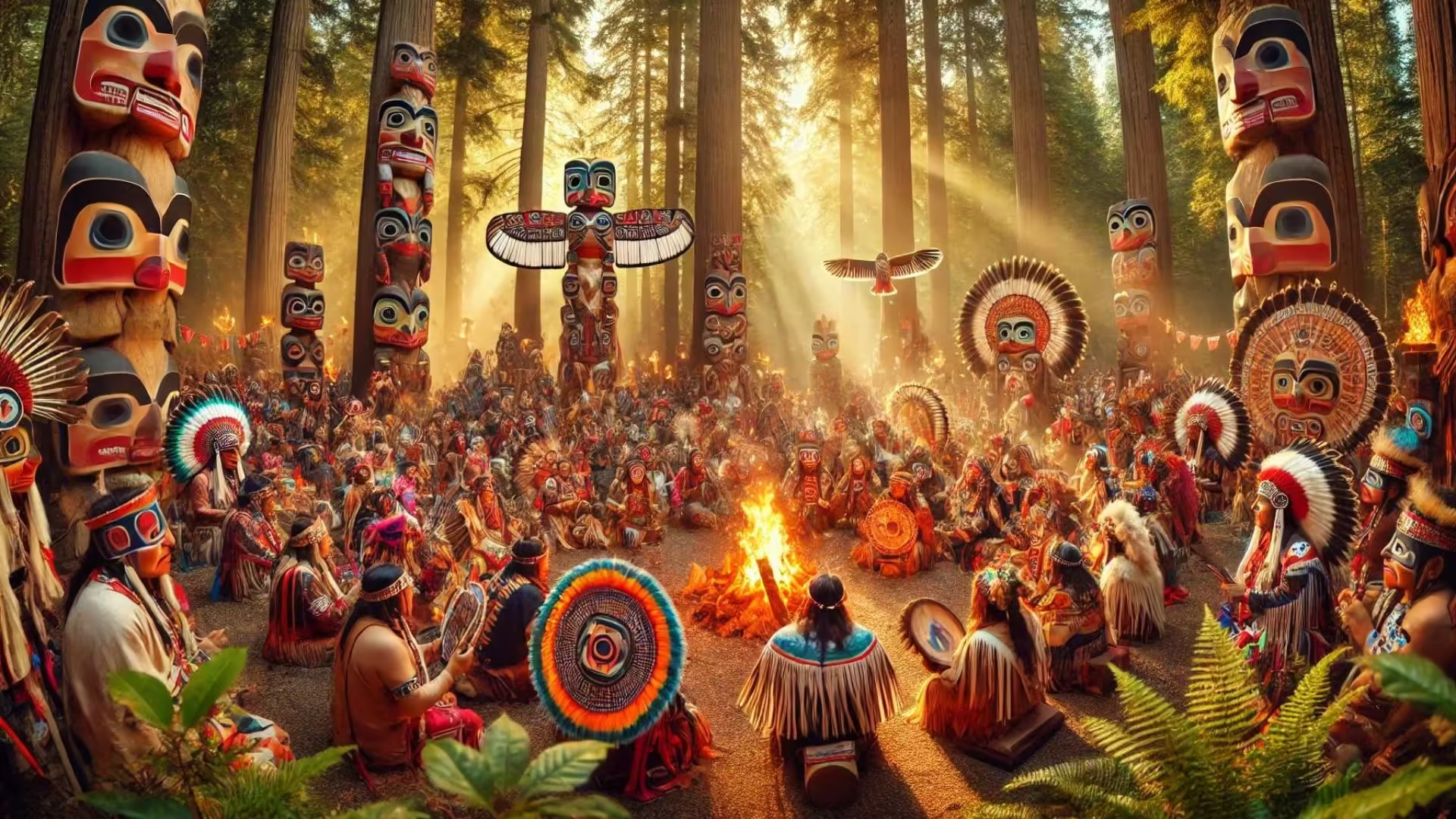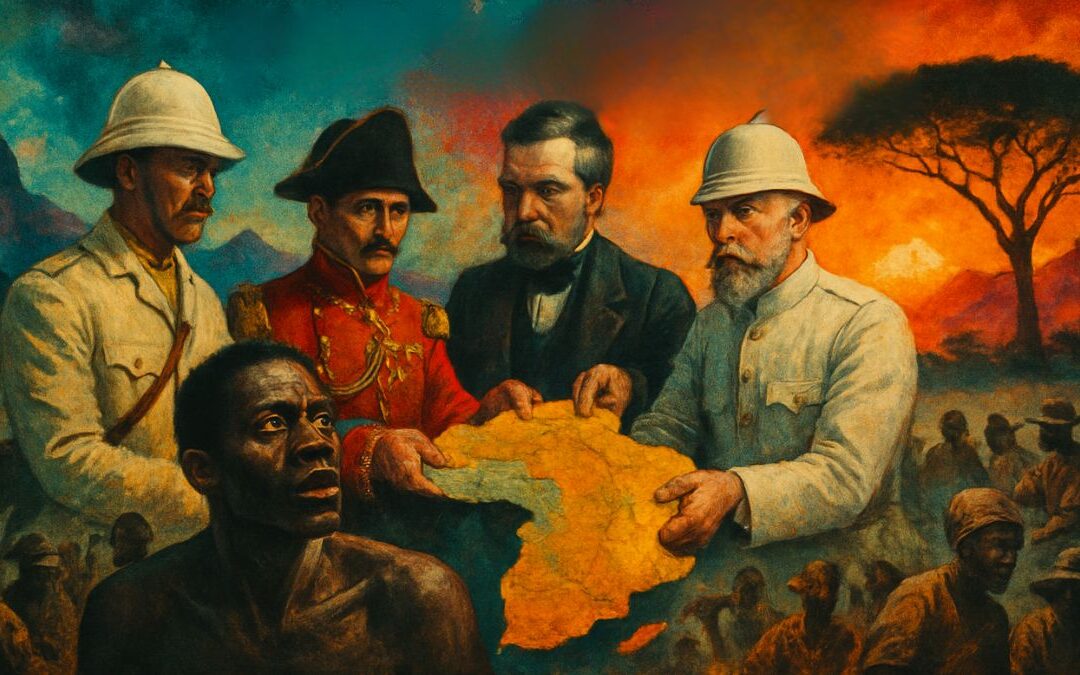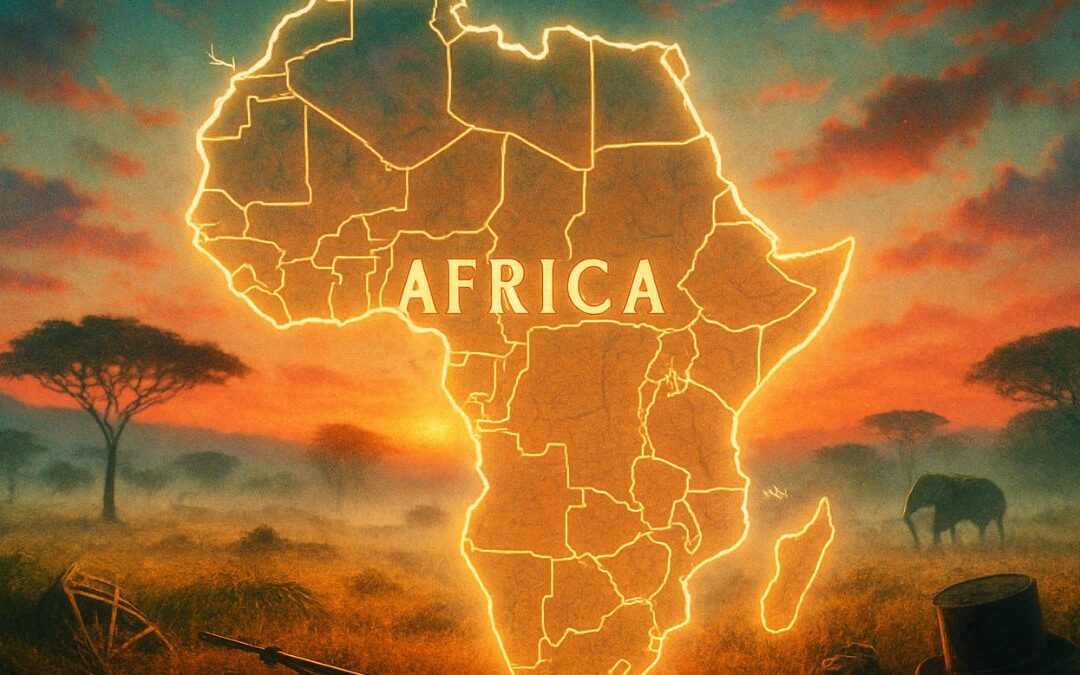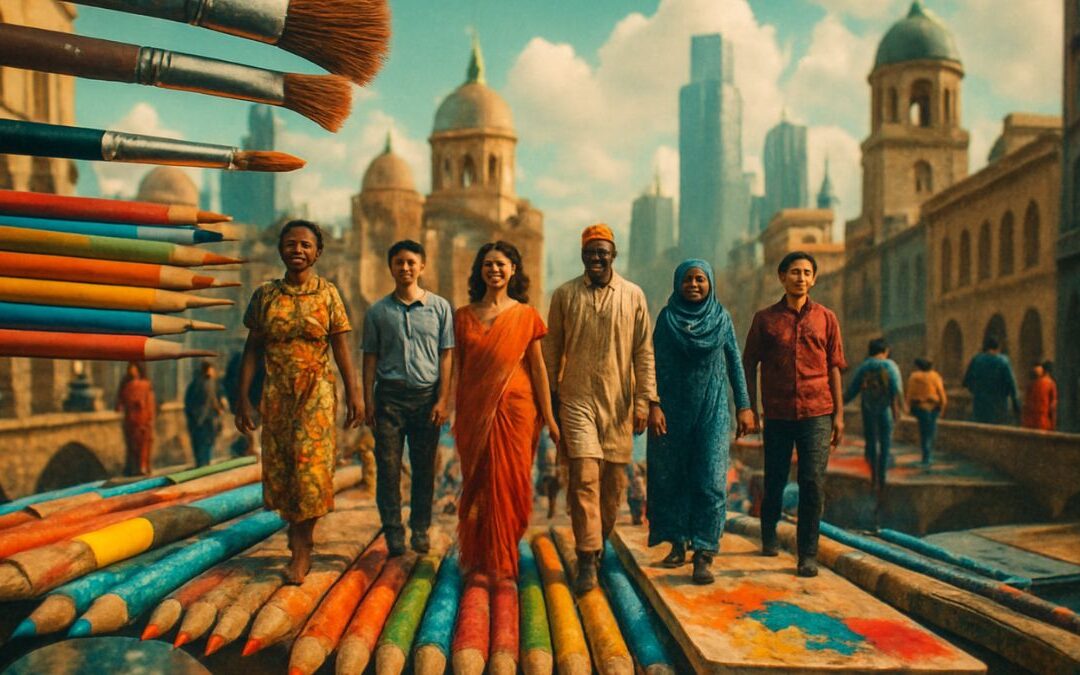- The Gist
- Understanding Canada’s First Nations’ Potlatch Ceremony: A Tradition of Culture and Community
- The Origins and Purpose of the Potlatch Ceremony
- Storytelling and Cultural Continuity
- The Potlatch Ban and Its Lasting Impact
- Potlatches in Modern Times
- The Significance of Potlatch Today
- Let’s Talk
- Let’s Learn Vocabulary in Context
The Gist
Understanding Canada’s First Nations’ Potlatch Ceremony: A Tradition of Culture and Community
The Potlatch Ceremony is a deeply significant cultural tradition among many of the First Nations peoples of Canada’s Pacific Northwest, including the Kwakwaka’wakw, Haida, Tlingit, and Nuu-chah-nulth. It’s far more than just a social gathering—Potlatches have historically been a central element in First Nations society, functioning as a way to reaffirm status, distribute wealth, pass down stories, and maintain social harmony. Despite efforts by colonial governments to suppress the tradition in the 19th and 20th centuries, Potlatches have endured and remain a vital part of First Nations cultural identity today.
The Origins and Purpose of the Potlatch Ceremony
The Potlatch, which means “to give” in the Chinook language, originated as a way to celebrate significant events such as marriages, births, the naming of children, and the passing on of titles. Traditionally, the Potlatch was a way for the host to display generosity and establish or reaffirm their status within the community. The act of giving, whether it was food, clothing, or ceremonial items, symbolized wealth, strength, and leadership.
In these societies, wealth wasn’t measured by how much you could accumulate but by how much you could give away. The Potlatch system reinforced a sense of community, as those who had more gave to those who had less. It was a way of redistributing wealth that helped maintain social balance and ensure everyone’s well-being within the group.
Storytelling and Cultural Continuity
A Potlatch wasn’t just about the distribution of goods; it was also a cultural and spiritual event filled with storytelling, music, and dance. Through these rituals, oral traditions were passed down, ensuring the continuity of First Nations history and identity. Elders and leaders used Potlatches to teach younger generations about their ancestry, their roles within the tribe, and the traditions that kept their culture alive.
One of the key elements of the Potlatch is totem pole raising, a ceremonial practice often included in the festivities. Totem poles, carved with symbolic animals and figures, tell stories about the host’s ancestry, clan lineage, or important historical events. The Potlatch would be the perfect occasion to unveil and celebrate a new totem pole, which served as a physical reminder of the family’s history.
The Potlatch Ban and Its Lasting Impact
Despite the rich cultural significance of the Potlatch, the Canadian government banned the ceremony in 1884 as part of its efforts to assimilate First Nations peoples into European-Canadian society. The government saw the Potlatch as a threat to this assimilation process, viewing it as a wasteful and non-Christian practice. The ban had a profound impact on First Nations communities, as they were forced to either stop practicing the tradition or continue holding Potlatches in secret.
Many ceremonial objects used in Potlatches, such as masks, blankets, and regalia, were confiscated by the authorities, often ending up in museums or private collections. This cultural suppression left a lasting scar on First Nations communities. However, the resilience of the people was evident when the Potlatch ban was officially lifted in 1951. Since then, there has been a resurgence of Potlatch ceremonies, and many First Nations people have worked to reclaim their stolen artifacts and restore the traditional practices.
Potlatches in Modern Times
Today, the Potlatch remains a vital part of First Nations cultural life, particularly among communities in British Columbia. While modern Potlatches may look slightly different from those held in the past, the core principles of generosity, community, and cultural continuity remain. In some cases, Potlatches have taken on a new role as platforms for discussing contemporary issues facing Indigenous communities, such as land rights, environmental protection, and political advocacy.
Additionally, the Potlatch has become a symbol of resistance and resilience—a reminder of the strength of First Nations people and their ability to maintain cultural identity despite centuries of oppression. It serves as a powerful reminder of the importance of cultural preservation and the value of community in a world that often prioritizes individualism.
The Significance of Potlatch Today
The Potlatch Ceremony is more than just an ancient tradition; it’s a living, breathing part of the First Nations’ identity. It offers valuable lessons about the importance of giving, the power of storytelling, and the significance of cultural preservation. Potlatches are a reminder that wealth isn’t about material possessions but about the strength of your community and the wisdom you pass down to future generations.
In conclusion, understanding the Potlatch Ceremony helps us appreciate the rich cultural heritage of Canada’s First Nations. It also highlights the resilience of Indigenous peoples in maintaining their traditions, even in the face of adversity. Today, Potlatches continue to be a symbol of identity, connection, and pride for First Nations communities.
Let’s Talk
The Potlatch Ceremony is such a fascinating tradition, isn’t it? When you think about it, the core idea—showing your wealth by giving rather than accumulating—feels so different from how we often view success today. Imagine if, instead of measuring success by what we own or hoard, we measured it by how much we could share with others. It kind of flips the script on modern ideas of status and wealth, doesn’t it?
But let’s take it a step further. The Potlatch isn’t just about giving material goods; it’s about community, storytelling, and passing down knowledge. In a way, it’s a form of wealth that goes beyond possessions. Think about your own life for a moment. What stories or lessons have been passed down to you that have shaped who you are today? Maybe it’s something your grandparents shared with you, or a lesson from a mentor. Those moments are a type of wealth too, aren’t they? And just like in the Potlatch, we have a responsibility to pass those things on—to share what we’ve learned with others.
Now, here’s a thought: What if we practiced a little “modern Potlatch” in our daily lives? I’m not saying you need to throw a big ceremonial feast (although that does sound like fun), but what if we made it a point to share more—our time, our stories, our resources—with the people around us? How would that change the way we interact with our communities? There’s something powerful in that idea of giving not to gain recognition or status but simply because it strengthens the bonds between people.
Another thing that stood out to me is how resilient the First Nations have been in preserving the Potlatch despite attempts to suppress it. It’s a reminder of the strength of cultural traditions, especially when they’re rooted in values like community and generosity. And I think that’s something we can all relate to in one way or another—holding onto the things that are important to us, even when it feels like the world is pushing us in another direction. Have you ever felt the need to hold on to a tradition or practice in your life, even when it wasn’t the “popular” thing to do? It makes you realize how essential these rituals and customs are in grounding us, doesn’t it?
Lastly, there’s the importance of storytelling in the Potlatch. Through songs, dances, and oral histories, the First Nations people have used the Potlatch to keep their stories alive for generations. It makes me wonder: How often do we stop and think about the stories we’re telling in our own lives? Not just the ones we share with others, but the stories we tell ourselves. Are they stories of resilience, of growth, of generosity? Or are they stories that keep us stuck in one place? Maybe there’s something to be learned from the Potlatch about the power of storytelling—not just in preserving history, but in shaping our future.
So, what do you think? Could we all use a little more of that Potlatch spirit in our lives? How might practicing generosity and sharing stories in a more intentional way change the way we see our own communities? It’s something worth reflecting on, don’t you think?
Let’s Learn Vocabulary in Context
Let’s explore some of the key vocabulary from our discussion about the Potlatch Ceremony and see how they fit into everyday conversations. First, we’ve got Potlatch itself. In the context of Canada’s First Nations, it refers to a ceremonial gathering where wealth is redistributed, and important social events like marriages and births are celebrated. But in a broader sense, you can use Potlatch to describe any event where people come together to share resources or celebrate something significant. For example, think of a community gathering where everyone brings food to share—that’s a modern-day version of a Potlatch in spirit.
Next is wealth redistribution. During a Potlatch, wealth isn’t hoarded—it’s shared with the community. In our daily lives, we might hear this term in discussions about economics or charity, where the idea is to balance wealth between different groups. But it can also apply to how we share our own resources. Do you ever find yourself giving away clothes you don’t wear anymore or donating to a cause you believe in? That’s your own small form of wealth redistribution.
Now let’s look at storytelling. In the Potlatch, storytelling is a way to pass down history, traditions, and values from one generation to the next. It’s not just about entertainment—it’s about preserving culture. In real life, we all use storytelling, whether it’s sharing memories with friends, explaining a personal experience, or teaching someone a lesson through a story. Stories help us make sense of the world, and they’re a powerful way to connect with others.
Then there’s cultural continuity. This is the idea of maintaining and passing on cultural practices and beliefs over time, despite challenges or changes in the world. In the context of the Potlatch, it refers to how the First Nations have kept their traditions alive, even when they were banned. In our everyday lives, cultural continuity might be as simple as carrying on family traditions, whether it’s a holiday meal or a particular way of doing things that’s been passed down through generations.
Finally, let’s talk about resilience. The Potlatch ceremony is a testament to the resilience of the First Nations people, who held onto their traditions despite efforts to suppress them. Resilience is the ability to bounce back from challenges and keep going, no matter what obstacles come your way. In daily life, you show resilience every time you face a tough situation—whether it’s getting through a bad day at work or overcoming a personal setback—and find a way to keep moving forward.
So here’s something to think about: How do you practice storytelling in your own life, whether it’s with family, friends, or even through the stories you tell yourself? And when it comes to resilience, what are some ways you’ve shown strength in holding on to what matters most to you, even when things weren’t easy? These questions can help you reflect on how some of the themes from the Potlatch ceremony connect to your own life.










0 Comments